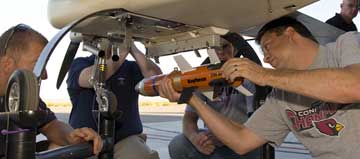UAV's (Unmanned Aerial Vehicles) have been proven in Afghanistan as armed and deadly surveillance aircraft. Up till now, though, only the bigger ones carried any ordnance to speak of, and these consisted primarily of 500 lb bombs or Hellfire missiles. The guys in the field operate many more smaller drones, and while they can see insurgents planting IED's in the road, they can't do anything about it other than calling home for some firepower.

The American Industrial Complex has stepped up to the plate to remedy this situation. Raytheon has just finished testing it's prototype small munition called Pyros, intended to be installed on smaller UAV's. Weighing in at only 11 to 13 lbs., it's a small munition without any propellant, more like a laser guided gravity bomblet. Tests so far have the bomb being detonated within a few feet of it's intended target. It has a sensor package that also will detonate the bomb at a prescribed height above the ground, which is really devastating. The target of these small munitions are presumed to be insurgents, say a group of three, planting an IED in the road. The Pyros bomb can detonate close to them, and the small charge will definitely take them out, containing collateral damage.
Whether you agree with this sort of strategy or not will not stop it from being developed. The US at the moment is the majority holder of these technologies, but they will spread to other countries, some we wouldn't want to have them. I think we can't even imagine yet what future wars will look like, but you can bet autonomous robots will be part of them. And as the bombs get smaller and smaller, and the robots get smaller too, I can envisage nano bombs being carried by insect sized robots, creeping up, and not being noticed or deadly till enough of them are around you.

